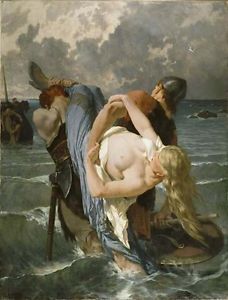On a Viking trouser-snake

I’ve a crick in my neck,
And tend to fall on my head,
My trouser-snake is soft,
And my hearing’s gone away.
The extract above is from Judith Jesch’s translation of a lament on old age by the 10th century Viking skald (or poet) Egil Skallagrimsson.
The image is a 19th century French painting by Evariste Vital Luminais. The first publisher of my novel, The Viking Hostage, suggested using this painting on the book’s cover, which I roundly rejected, as I am trying to break stereotypes of Vikings in the novel.
The Viking Hostage imagines a viking settlement on an island off the coast at Tenby in Wales. (There were real Viking settlements on the Welsh islands and my fictional island is a blend of Caldey and Skomer.) I was talking a while back with a TV researcher about why contemporary people from the Welsh coast, might like the idea of having Viking DNA, despite the popular image of Vikings as brutal raiders and slavers (which indeed they were). Nevertheless, we can’t help but be impressed by the adventurous spirit of the Vikings and their achievements as seaborne explorers.
I’m intrigued by the way that Vikings might have seen the map of the world, inside out as it were, from the perspective of the oceans and rivers that were their roads. One of their ‘roads’ skirted through the Scottish islands and came down past the Isle of Man, threaded between Ireland and Wales, and moved on towards France.
I tried to write about Vikings as fully rounded people, rather than two-dimensional villains, as tender and funny, as well as fearsome pagan warriors. 8th to 11th century Scandinavia (the Viking Age) was a rich and complex culture as the British Museum’s 2014 exhibition, Vikings, demonstrated.
There is evidence that Viking women were on some of the ships and evidence that some of them were warriors. Stories of the red maiden, a red-haired female warrior, on the ships off the Welsh coast, were among the inspirations for my novel. Vikings were also traders, farmers and mercenaries, integrating with the other cultures they encountered.
Evidence about the Vikings in Wales is in place names especially islands and coastal ports; in the Icelandic Sagas; in recent archaeological evidence, for instance at Anglesey; and in the Welsh Annals written at St David’s Cathedral where they had good cause to moan about them since Vikings raided the cathedral eleven times.
See Judith Jesch’s Viking Poetry of Love and War (2013) published by the British Museum; Mark Redknap, Vikings in Wales: An Archaeological Quest (2000); Gareth Williams and Peter Pentz’s Vikings: Life and Legends (2014); and the Vikings television drama series.
France was another place where there was good reason to think of Vikings with less than fondness. My novel, The Viking Hostage, set in France and Wales, is published by Meanda Books.
BUY THE BOOK



